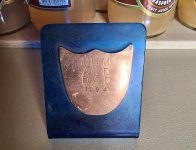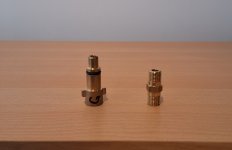DFB
Well-known member
- Aug 12, 2019
- 5,058
- 3,323
- Thread starter
- #2,401
Swung by my friends workshop this morning, and with his large panel saw, the plywood was cut to size in no time. Two 1840mm x 600mm sections.
 IMG_4735 by D B, on Flickr
IMG_4735 by D B, on Flickr
In Year 10 I did a week's work experience with the gentleman above. At the time, I was mad on woodwork and cabinetry, which started in Year 7 woodwork class. Funnily, I started out hating that class, which was mandatory for all Year 7 students and. If I'm honest, it was simply because of a lack of confidence and a high amount of self-consciousness that was holding me back. But................somehow woodwork ended up being one of my favorite classes, of which I carried right through into Year 12. Go figure.
Anyway, I remember on day one of that work experience being set up to apply laminate edge banding on "white board" (melamine). Back then, this was done by hand using a hot iron to activate the adhesive, smoothed over with a cork block, then trimmed with a hand file in a very specific technique, as shown below. Well, being a ball of anxiety, the first stroke of the file was an instant failure, to which I let slip "I fu.ked it up"..................to hysterical laughter from my mentor. I did eventually get the hang of it, I actually enjoyed the task in the end and could probably still do it now.
Of course, there are various methods of applying and trimming edge banding these days, depending on the shop volume and budget. No more "fu.king it up"...................
I had originally planned on making these cuts myself using a circular saw that dates back to my mid-teens, anyone remember GMC tools, basically what Ozito is today. Anyway, I didn't have a long enough straight edge to make a perfect cut, nor did I want to buy one for the mere three cuts I needed it for, then have to store the bloody thing somewhere.
 gmccs1 by D B, on Flickr
gmccs1 by D B, on Flickr
Once cut to size, I cleaned up the plywood edges with the sander, then a final sand of the facing sides. I really love this M18 palm sander, so convenient to use and seems to be quite efficient in terms of power usage/battery life.
https://www.totaltools.com.au/124405-milwaukee-18v-125mm-random-oribital-sander-m18bos1250
 IMG_4739 by D B, on Flickr
IMG_4739 by D B, on Flickr
It was then out with the paint brush to continue applying the polyurethane.
 IMG_4736 by D B, on Flickr
IMG_4736 by D B, on Flickr
Once I have the painting done, one piece of the plywood will provide a sturdier surface for my work bench, the existing sheet metal panels are just too thin and end up clanging as the deforming under weight. The second will become a backing piece for a unique splash back I have in mind.
 IMG_4684 by D B, on Flickr
IMG_4684 by D B, on Flickr
 IMG_4735 by D B, on Flickr
IMG_4735 by D B, on FlickrIn Year 10 I did a week's work experience with the gentleman above. At the time, I was mad on woodwork and cabinetry, which started in Year 7 woodwork class. Funnily, I started out hating that class, which was mandatory for all Year 7 students and. If I'm honest, it was simply because of a lack of confidence and a high amount of self-consciousness that was holding me back. But................somehow woodwork ended up being one of my favorite classes, of which I carried right through into Year 12. Go figure.
Anyway, I remember on day one of that work experience being set up to apply laminate edge banding on "white board" (melamine). Back then, this was done by hand using a hot iron to activate the adhesive, smoothed over with a cork block, then trimmed with a hand file in a very specific technique, as shown below. Well, being a ball of anxiety, the first stroke of the file was an instant failure, to which I let slip "I fu.ked it up"..................to hysterical laughter from my mentor. I did eventually get the hang of it, I actually enjoyed the task in the end and could probably still do it now.
Of course, there are various methods of applying and trimming edge banding these days, depending on the shop volume and budget. No more "fu.king it up"...................
I had originally planned on making these cuts myself using a circular saw that dates back to my mid-teens, anyone remember GMC tools, basically what Ozito is today. Anyway, I didn't have a long enough straight edge to make a perfect cut, nor did I want to buy one for the mere three cuts I needed it for, then have to store the bloody thing somewhere.
 gmccs1 by D B, on Flickr
gmccs1 by D B, on FlickrOnce cut to size, I cleaned up the plywood edges with the sander, then a final sand of the facing sides. I really love this M18 palm sander, so convenient to use and seems to be quite efficient in terms of power usage/battery life.
https://www.totaltools.com.au/124405-milwaukee-18v-125mm-random-oribital-sander-m18bos1250
 IMG_4739 by D B, on Flickr
IMG_4739 by D B, on FlickrIt was then out with the paint brush to continue applying the polyurethane.
 IMG_4736 by D B, on Flickr
IMG_4736 by D B, on FlickrOnce I have the painting done, one piece of the plywood will provide a sturdier surface for my work bench, the existing sheet metal panels are just too thin and end up clanging as the deforming under weight. The second will become a backing piece for a unique splash back I have in mind.
 IMG_4684 by D B, on Flickr
IMG_4684 by D B, on Flickr



































